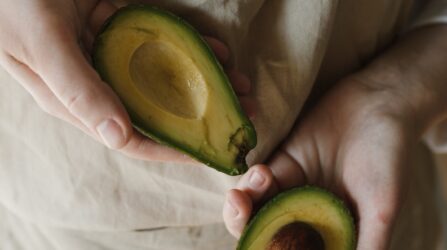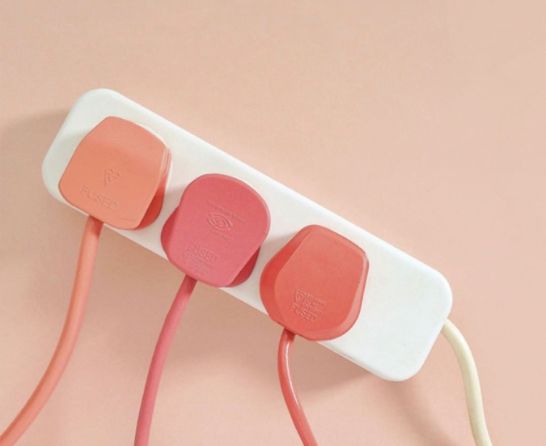Home > Female Body > Menstrual cycle > Eat for your Cycle: Foods that make period cramps worse


If there’s one universal truth, it’s that period pain sucks. We know the feeling: Curled up on the couch, cuppa in hand, and the painkillers just aren’t pulling their weight. But what if we told you that your diet could, in fact, be negatively impacting your pain? Today, we’re talking about foods that make period cramps worse. You may not love us for this one, but chances are you’ll be thanking us later.
Now, what we’re talking about today is backed by research. That being said, you know what works for you. Although a period pizza party probably won’t purge you of your pain, it may quite literally rescue you from the depths of hormonal hell. Guilt is the last thing you’d want to add to that catalog of emotions.
So, while this is all factual stuff, it’s not the law. If your cravings are hitting and ice cream/pizza/chips/all of the above is what’ll fix it, no judgment here.
Before we talk about the food, let’s quickly talk about why periods are so damn painful in the first place.
During menstruation, your uterus contracts while shedding its lining. This contraction restricts the blood vessels that line it, temporarily cutting off the blood and oxygen supply. Your body really doesn’t like that. So it reacts by kicking off a bunch of swelling and producing chemicals that cause pain.
One of these chemicals is Prostaglandin, AKA our period pain prime suspect. Once produced, Prostaglandins actually encourage the womb muscle to contract further, resulting in, you guessed it, more pain. Fun so far, right?
A study undertaken at the University of Auckland found that those who experience severe pain during their periods have, in general, higher levels of Prostaglandins in their menstrual fluid. Pain usually starts when bleeding begins and lasts two to three days on average. Though we all know that feels like an eternity. Cramps tend to be more acute in those under thirty years of age, those who have recently started menstruating, and those who tend to experience irregular bleeding. The pain is usually at its worst when your bleeding is at its heaviest.
Sadly, all is not fair when it comes to periods and pain. Underlying health conditions such as fibroids, endometriosis, pelvic inflammatory disease, or adenomyosis are all likely to increase pain levels. If, for any reason, your period pain stops you from living your life, please talk to a trusted healthcare professional.
So, avoiding any extra inflammation around your period is a pretty good idea. The good news is that your diet can actually help you with that. And, before you ask, you don’t have to surrender your tastebuds to a bland roster of pain-purging foods. No, really…
Hear us out because this is a big one: Sweet foods will make your period cramps worse. That’s a fact. Processed sugar is highly inflammatory, meaning it works to increase the blood supply to your already contracted uterus while restricting the muscles even further. This leads to heavier, and more painful, bleeding. Who knew?
A high intake of sugar can also spike your blood sugar levels, encouraging the production of Insulin. Estrogen and Progesterone have a pretty erratic relationship with Insulin, meaning a hormonal imbalance might be on the horizon, at a time you’re already feeling a little wobbly. But that’s not all, because when our blood sugar levels drop again a few hours later we feel, well, pretty awful… And then do it all over again.
We’re not telling you to completely cull the chocolate when you need it the most, though. Maybe try swapping your sweet milk bar for a darker alternative. It’s also worth giving water-rich fruits a try. They’re packed with natural sugars that will satisfy your cravings without the spike that refined sugars cause.
Yup, dairy-rich foods will probably make your period cramps worse. Why? Dairy contains inflammation-inducing arachidonic acid, which preys on your already tender uterus. It can also upset your digestion, causing bloating and gas.
But here’s the kicker. The calcium found in dairy also happens to be super-handy when it comes to your preventing painful spasms. You may find that reducing your intake here and there is enough to ease your pain. For those looking for some plant-based alternatives, nuts, seeds, grains, and leafy greens are all great calcium-rich options.
Thanks to the high levels of Prostaglandins, red meat is one of the foods that will definitely make your cramps worse. It may be best to opt for some oily fish that’s packed with healthy nutrients. If you don’t want to part ways with red meat, however, try opting for less processed alternatives.
We know. We love them too. But fried foods tend to cause inflammation by triggering our old friend Prostaglandins. Salt and trans-fats are also very present in fried foods, meaning they could increase your Estrogen levels. We recommend staying hydrated and trying to limit your intake of fried meals and snacks where you can.
Believe it or not, eating cold food during your period might encourage the release of Prostaglandins. This thinking has roots in Ayurvedic medicine but rings very true with modern science. That’s why we recommended heat treatments and warm food and drink for dealing with cramps.
Now, we’ve addressed the big inflammatory offenders. But there are a couple more foods to look out for. Though not inflammatory, they might not be as kind to your body as you’d like them to be.
Salt-rich foods tend to make period cramps worse. A high salt intake encourages water retention, causing bloating and dehydration. Tinned and processed foods are the big offenders here. It’s best to keep hydrated and get plenty of fresh food during your period as it can thin your blood and ease cramps.
If you’re anything like us, a period means it’s time for a takeaway. But you may want to skip that curry. Or Jerk chicken. Spicy foods can make your cramps worse by upsetting your digestive system when it’s already feeling a little vulnerable. If you tend to be sensitive to spice, then you may experience more intense symptoms, like diarrhea, stomach pain, and nausea.
Forgive us for stating the obvious, but it’s worth a mention. Anything that disagrees with you during the rest of the month will probably make your cramps worse. If you’re a tad lactose intolerant, you might see your period as the perfect time to reconnect with Ben and Jerry. But hold your horses. Because that Phish Food will probably add to the nausea, cramping, and irritability that you’re probably already experiencing.
Period or no period, alcohol has a pretty impressive rap sheet, including digestive issues, diarrhea, and nausea. But that’s not all. Not only does it interfere with your Estrogen and Testosterone production, making you more likely to feel irritable, but it also dehydrates you. Hydration is essential during menstruation. Water works to thin your blood, allowing it to flow more easily around your body. It also eases the cramping of your muscles.
Caffeine is a bit of a double threat when it comes to your period pain. It encourages water retention, causing bloating, headaches, and digestive issues. Meanwhile, it also works to slow the flow of blood in the vessels that feed your uterus, leading to further contraction and pain.
That being said, there are a host of side effects associated with caffeine withdrawal. Headaches, irritability, and fatigue are just for starters. So maybe don’t cut coffee out completely. Reducing your intake by a couple of cups a day, alongside subbing with decaf here and there, will make your life so much easier.
Ok, so you’re looking after your diet and reducing all those inflammatory foods. But your timing is just as important. Whatever you decide to eat and drink during your period, do it regularly and with lots of water Why? This will keep your circadian rhythm in check which can alleviate cramps. Oh, and late-night snacking isn’t generally recommended, but we won’t tell if you don’t.
Yes, we know we’ve basically shown you that everything that makes you feel better actually probably makes you feel worse. And, for that, we are truly sorry. But here’s the thing, gang: everything in moderation, right?
Looking out for your mental health is just as important as tending to your cramps, so never feel bad for giving in to those cravings. It’s about working out what’s right for you. And that just might come down to some mildly annoying food trial and error. Let us know how you get on!
Disclaimer: This website does not provide medical advice. The information, including but not limited to, text, graphics, images and other material contained on this website are for informational purposes only. No material on this site is intended to be a substitute for professional medical advice, diagnosis, or treatment. Always seek the advice of your physician or other qualified healthcare provider with any questions you may have regarding a medical condition or treatment, and before undertaking a new health care regimen, and never disregard professional medical advice or delay in seeking it because of something you’ve read on this website.

-


Dr Singh is the Medical Director of the Indiana Sleep Center. His research and clinical practice focuses on the myriad of sleep.

The importance of the follicular phase While it may not be the most fun part of the menstrual cycle, the follicular phase plays a key role in your reproductive health. As we mentioned, the follicular phase begins on the first

Understanding female hormones If you’ve never heard that women have specific feminine hormone levels, you’re probably wondering, “What are the female hormones and how many hormones do women have? Female hormones are hormones released in higher concentrations in a woman’s

Understanding estrogen and its role in pregnancy Estrogen is one of the most important sex hormones, impacting every part of the fertility process. During your menstrual cycle, estrogen levels influence LH production, which triggers ovulation. While progesterone is responsible for
Hormona© 2025, All Rights Reserved
Privacy Overview
| Cookie | Duration | Description |
|---|---|---|
| cookielawinfo-checkbox-analytics | 11 months | This cookie is set by GDPR Cookie Consent plugin. The cookie is used to store the user consent for the cookies in the category "Analytics". |
| cookielawinfo-checkbox-functional | 11 months | The cookie is set by GDPR cookie consent to record the user consent for the cookies in the category "Functional". |
| cookielawinfo-checkbox-necessary | 11 months | This cookie is set by GDPR Cookie Consent plugin. The cookies is used to store the user consent for the cookies in the category "Necessary". |
| cookielawinfo-checkbox-others | 11 months | This cookie is set by GDPR Cookie Consent plugin. The cookie is used to store the user consent for the cookies in the category "Other. |
| cookielawinfo-checkbox-performance | 11 months | This cookie is set by GDPR Cookie Consent plugin. The cookie is used to store the user consent for the cookies in the category "Performance". |
| viewed_cookie_policy | 11 months | The cookie is set by the GDPR Cookie Consent plugin and is used to store whether or not user has consented to the use of cookies. It does not store any personal data. |
